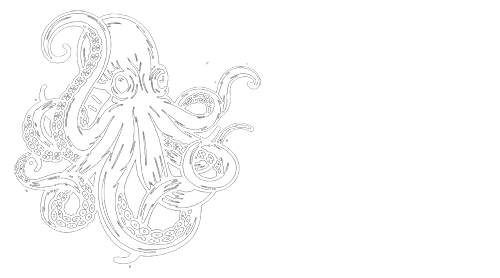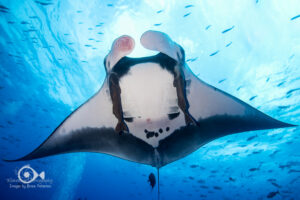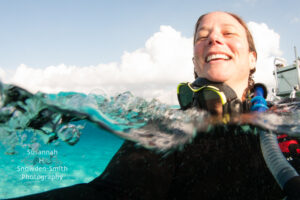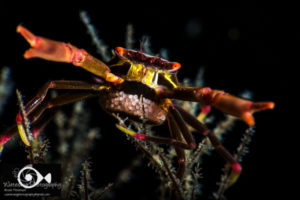
The definition of backscatter is the deflection of radiation or particles through an angle of 180 degrees. What this means in photography and especially underwater photography is that light coming from the direction of the camera lens will bounce off particles in front of the lens and be deflected directly back into the lens. So tiny particles that would normally remain unseen become like little mirrors reflecting light back into the lens. This appears as bright specks in a photograph that look like sharp pinpricks of light when they are in focus. They look like aperture shaped blotches when they are out of focus.
Another example of backscatter is actually strobe flare. This happens when the strobes are a bit too far forward so that their light is reflected off the sides of the dome port glass. The solution to this is to pull the strobes back so that the head of the strobe is behind the handles of your camera housing.

Actually, a solution to both problems is to pull the strobes back so that the head of the strobe is behind the handles of the camera housing. In addition, turning the strobes down a bit can help to reduce backscatter. Many photographers suggest turning the strobes slightly out or in to help reduce backscatter, but I find that this has little effect. The light coming from the strobes is usually diffused enough that the angle of light is broad and turning them out has no effect on the angle of deflection. What does change, though, is whether the strobes are lighting up particles in front of the lens or to the sides of the image. Remember that the light coming out of the strobe head is in the shape of a cone. When you have two cones of light, one on each side, those cones will intersect in front of the lens.
If the cones of light meet right on your subject, there will be no backscatter in front of the subject because there is no light there. This is not to say there will be no particles in front of your subject though. It is just a matter of whether they will show up or not. Other solutions to avoiding backscatter include getting close to the subject so that there is not much space between the strobes and the subject. Having good buoyancy control can help reduce the actual number of particles in the water.
The image below was taken without strobes using ambient light and a magic filter.
This image has a few (but not many) white particles showing in the blue water. This is an example of what backscatter is NOT. This image simply shows some out of focus particles that were floating by in the water. We tend to call it backscatter, because it looks much the same, but since there is no light being deflected from the strobes, it is just particles in the water. The question is, does it really matter?
From this underwater photographer’s standpoint, no. It does not matter. I still dislike the particles floating in the water, whether they are backscatter or not. But in this case, there is nothing I can do to keep those particles out of the image. When dealing with backscatter, a photographer can reduce it by turning down the strobes and pulling them back behind the handles of the housing, or by reducing the space between the subject and where the cones of light from the strobes intersect.
Sometimes, though, particles may be integral to the image. Think, for example, of a person standing in a snowstorm. If the snowflakes don’t show up in the photograph, then you would never know a snowstorm is happening. However, if you used a strobe, and the light deflected off the snowflakes back into the lens, you would have a bunch of bright dots instead of snowflakes, probably ruining the image.
The same concept is true in underwater photography. Sometimes the particles in the water are integral to the image. Often, blackwater images have lots of particles in the water around the subject. This helps convey the idea that it was night and the subject was in mid-water. It also gives a sense of dimension. When you have particles that are out of focus, they appear larger and are of varying size. This helps the viewer see that there is distance between the subject and the particles and it makes the image more dimensional.

In contrast, look at the image of the coral polyp with all backscatter removed. Which image do you like better?

In the end, how much backscatter or particles are in the finished image is completely subjective. Both can be removed with post-processing software, such as Adobe Photoshop, but a good photographer wants to create the best image possible in camera. The issue in question is whether the particles in the image distract the viewer from the subject. If so, then clean it up in post. The point of this discussion is to recognize when backscatter can be reduced to produce a better image, and when nothing can be done because it either is not backscatter in the first place, or because there is always a risk of particles deflecting light under water. Try to keep in mind that all water has some particles floating in it and that is part of underwater photography. However, you should make an effort to reduce as much as possible when making the image, and remove what you don’t want in post. That being said, don’t be afraid to leave some of it in!
Join me for a workshop! Travel to a great destination where you will have exclusive coaching on your underwater photography. Meet new people, network, try new techniques, and learn with the pros! Click on Travel and Workshops for more information!
Subscribe now!
As always, if you enjoy my images please visit my website, waterdogphotography.com, or give me a like on Facebook at Waterdog Photography Brook Peterson. Don’t forget to follow me here at waterdogphotographyblog and please feel free to share on Facebook or other social media.
My photographs are taken with a Nikon D810 in Sea and Sea Housing using two YS-D2 Strobes.
All images and content are copyrighted by Brook Peterson and may only be used with written permission. Please do not copy or print them. To discuss terms for using these images, please contact me.
copyright Brook Peterson 2018






